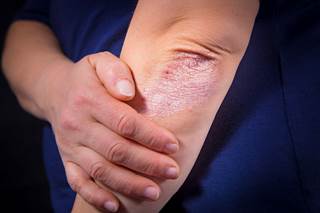February 01, 2019
Share this content:
 Obesity is an independent risk factor for development of psoriasis and is associated with a worse prognosis.
Obesity is an independent risk factor for development of psoriasis and is associated with a worse prognosis.Psoriasis and obesity have a complex interrelationship. Obesity is a common comorbidity in patients with psoriasis and observational studies initially pointed to a greater likelihood of obesity in these patients, suggesting it might be a risk factor for the development of psoriasis.
Carrying excess weight both exacerbates the manifestations of psoriasis and interferes with treatment;1 weight loss is associated with an improvement in symptoms.1 These factors point to an important link between the two diseases, although they do not necessarily share a common mechanism. As Stephen M. Schleicher, MD, director of the DermDOX Center for Dermatology in Hazleton, Pennsylvania, explained to Dermatology Advisor, psoriasis is an inflammatory process linked to immune dysfunction, while obesity has multiple origins.
Obesity, as measured by body mass index (BMI) [results in an] increased [risk] for developing psoriasis,” Dr Schleicher said, adding that “independent of BMI, there is a higher risk for developing psoriasis with weight gain for both males and females.” Results from the HUNT study, which prospectively examined data from 33,734 people in the general population in Norway, found that long-term increases in body weight of even 1 standard deviation substantially increased the risk for psoriasis and that obesity and large waist circumference doubled the risk.2
Possible Linked Mechanisms
Psoriasis is believed to be caused by a perfect storm of genetics, immune dysfunction, and environmental triggers. While it has been linked to multiple features of metabolic syndrome — including dyslipidemia, insulin resistance, diabetes, and obesity — obesity in particular may influence the development and expression of psoriasis as a direct result of inflammation. Current theory points to an important inflammatory role of visceral fat produced by adipose tissues, in which cytokines ([tumor necrosis factor] TNF-α, [interleukin] IL-6, IL-17) and adipokines (adiponectin, omentin, chemerin) contribute in multiple ways to the development of psoriasis, as well as metabolic syndrome.
Obesity is an independent risk factor for the development of psoriasis and is associated with a worse prognosis.4 In a commentary linked to the HUNT study, Gisondi and Girolomoni3 suggested that a disequilibrium of pro- and anti-inflammatory cytokines in obese individuals creates a state of chronic low-grade inflammation, which could create an opportunity for psoriasis to develop de novo or worsen in people who have already been diagnosed with psoriasis. While a number of studies have linked the presence of psoriasis to a greater risk for metabolic syndrome,4,5 whether or not psoriasis increases the risk for obesity is not as clear. In a 2016 review, Chirocozzi, et al4 first mentioned the possibility of a bidirectional mechanism when they suggested that “psoriasis-signature proinflammatory cytokines may alter lipid metabolism, enhancing the risk of adiposity…” Further investigation is needed to confirm this.
The Impact of Obesity on Psoriasis Management
In addition to the effects of increased BMI and waist circumference on the risk for developing psoriasis, actual excess weight also complicates treatment. “Certain therapies for psoriasis (such as cyclosporine and ustekinumab) are dosed based on weight,” Dr Schleicher explained, which may contribute to poor response in some patients. Takeshita, et al6 reported in 2017 that responses to fixed-dose biologic therapies such as adalimumab, etanercept, and ustekinumab were reduced in obese patients, while responses to weight-based doses of infliximab were not affected. The investigators suggested that current regimens of fixed-dose biologic agents may be insufficient to adequately treat psoriasis in patients who are overweight or obese, while weight reduction may improve response to the current dose.
Also complicating treatment is a 2-fold higher risk for developing non-alcoholic fatty liver disease (NAFLD) associated with obesity in patients with plaque psoriasis.1 “Obese individuals are at greater risk for developing cirrhosis when treated with methotrexate,” Dr Schleicher said, noting that the risk was significant enough to warrant avoiding methotrexate therapy in patients who are obese. “Weight loss is also listed as an AE [adverse event] for apremilast,” he pointed out, “although many obese patients with psoriasis view this in a positive light.”
Another important factor in the relationship between psoriasis and obesity is that increased BMI compounds the cardiovascular risks posed by either psoriasis or obesity alone.1 “Obesity is linked to metabolic syndrome characterized by hypertension, elevated lipids, and insulin resistance. All of these factors contribute to increased morbidity,” Dr Schleicher said, suggesting that clinicians should encourage weight loss in patients who are overweight at clinic visits.
Related Articles
Treatment Strategies
Weight reduction is believed to reduce psoriasis severity and may have indirect benefits through improvement of diseases contributing to metabolic syndrome.4 “Excess weight contributes to other comorbidities associated with psoriasis,” Dr Schleicher observed. “Obese patients with psoriasis are urged to achieve and maintain a more ideal body weight,” he said, which is best accomplished by reducing caloric intake and alcohol consumption.
Chirocozzi, el al4 also suggested that designing treatment strategies aimed at balancing pro- and anti-inflammatory adipokine levels in patients with psoriasis who are obese could benefit both conditions and reduce further complications of metabolic syndrome.
 Follow @DermAdvisor
Follow @DermAdvisor
References
1. Jensen P, Skov L. Psoriasis and obesity. Dermatology. 2016;232:633-639.
2. Snekvik I, Smith CH, Nilsen TIL, et al. Obesity, waist circumference, weight change, and risk of incident psoriasis: perspective data from the HUNT study. J Invest Dermatol. 2017;137:2484-2490.
3. Gisondi P, Girolomoni G. The multifaceted association between psoriasis and obesity. Br J Dermatol. 2019;180:24.
5. Owczarczyk-Saczonek A, Placek W. Compounds of psoriasis with obesity and overweight. Postepy Hig Med Dosw (Online). 2017;71:761-772.
4. Chiricozzi A, Raimondo A, Lembo S, et al. Crosstalk between skin inflammation and adipose tissue-derived products: pathogenic evidence linking psoriasis to increased adiposity. Expert Rev Clin Immunol. 2016;12:1299-1308.
6. Takeshita J, Grewal S, Langan SM Et al. Psoriasis and comorbid diseases: Implications for management. J Am Acad Dermatol 2017;76:393-403.







